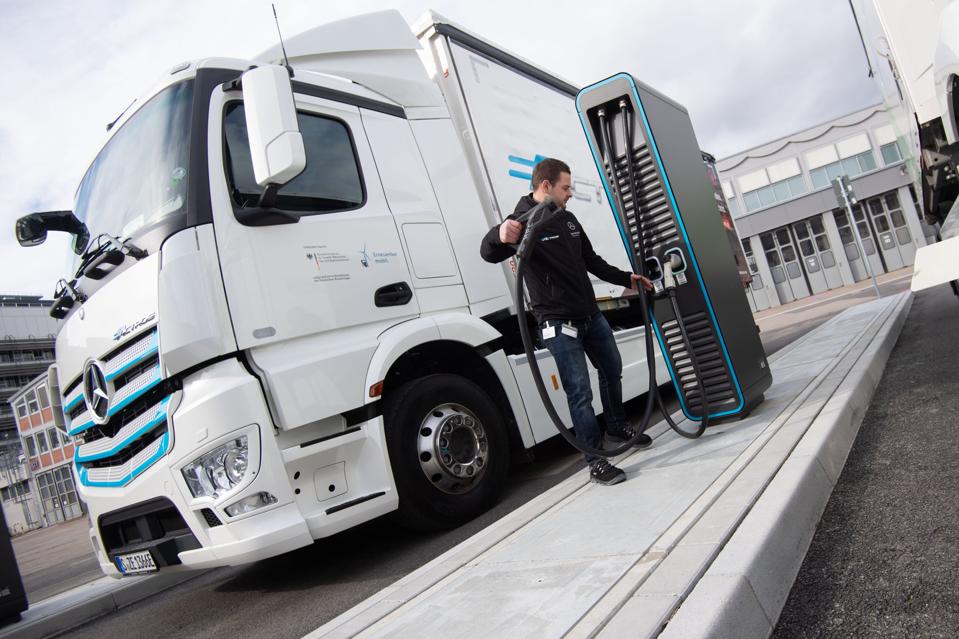The Mercedes-Benz eActros — coming to a charging station near you.
dpa/picture alliance via Getty Images
Transitioning to a low carbon economy is in progress. It is not political. According to the Yale Program on Climate Change Communication, a majority of Americans of both parties are in favor. Many sectors of the economy will face an accelerated drive to lower carbon emissions—transportation, electricity generation, agriculture, building materials. The Biden campaign climate initiatives have brightened the future for federal support. A carbon tax will hasten the changes and do so proportionately to the carbon emitted without picking winners. Consumers will decide how to reduce their emissions by deciding how much of a carbon tax they will pay.
In an analysis of the transition, a good place to start is with the heavy trucks that deliver the goods we use and the heavy garbage trucks that later haul away those goods. In a vacuum, what would it cost to change the fleet over to electric trucks? And are there other alternatives that could help solve our carbon challenge in an economically and technically feasible way?
Tesla, Paccar, Volvo are bringing electric semi-trailer trucks to the U.S. market in 2020 and 2021. State and local governments have provided direct incentives. Battery costs continue to decrease and productivity, or range, to improve. For consumers who mostly drive in-town, the full-cycle cost of electric cars — including the cost of acquisition, operating and maintenance — are less than that of a conventionally-fueled internal combustion engine. The operating cost for electric trucks appears to be no worse than those of diesel trucks. Turning over the fleet of commercial tractor-trailers appears doable.
The American Trucking Association counts 3.8 million Class 8 (heavy) trucks on American highways today, of which there are approximately 2 million tractor-trailers. In a vacuum, what would it cost to change the fleet over to electric trucks?
First-Order Costs and Benefits
New vehicle pre-virus prices for a diesel powered tractor range between $110,000 and $125,000, indicating a showroom value for the current fleet of tractor-trailers between $220 billion and $250 billion. The average price for a Class 8 truck, including tractor-trailers, is approximately $117,000, indicating a showroom value of approximately $445 billion for all heavy trucks.
Tesla is offering reservations for its electric big rigs starting at $150,000 (with a 300-mile range) and $200,000 (500 mile-range), and the company says the payback over the purchase of a conventional diesel-powered vehicle will be less than two years. Paccar and Volvo have also begun testing electric trucks and anticipate commercial sales beginning later this year. At the low end of $150,000 per unit, replacing all 3.8 million Class 8 trucks would cost approximately $570 billion.
The fleet of 3.8 million Class 8 trucks has an annual turnover of less than 10%. The New York Times recently cited an estimate that electric trucks will capture just 4% of annual truck sales through 2025. Accelerating the transition to all-electric by 2035 just for Class 8 trucks will require truck manufacturers to scale up beyond current production levels and abandon the production of diesel trucks. There will be stranded costs for current diesel truck manufacturers, but ramping up to frontload the transition to electric trucks means a severe recession for electric truck manufacturers after three or four years, as sales drop back to normal levels.
Carbon Price Impact
EPA data show 437.9 million metric tons of CO2 emissions annually from medium-duty and heavy-duty trucks. If the nation imposes a carbon tax of $100 per metric ton, the additional cost to the current fleet fueled by petroleum-based diesel would be approximately $43.8 billion per year, providing a significant incentive to change from diesel in a business driven by tight margins. Depending upon the generation source, electric vehicles produce 19% to 43% fewer GHG emissions than diesel trucks in the most efficient use on highways. At $100 per metric ton, the carbon tax savings to the nation’s truckers of an all-electric fleet would be $8.3 billion to $18.8 billion, an annual return of 1.5% to 3.3% on the total cost of a Class 8 vehicle replacement.
In today’s interest rate environment, that would be a darn good return.
Second-Order Impacts and Competition
The cost of installing quick charge stations around the nation and the necessary grid updates are difficult to estimate. The capital cost, a sunk cost, is real but essentially one-time. The repair industry will certainly lose employment simply because electric trucks have fewer mechanical parts to wear out. This is just speculation, but limiting the battery range for tractor-trailers will enforce stops for recharging and perhaps rest for the drivers pending full automation.
There are other potential solutions to decarbonizing the nation’s heavy truck fleet, however. Electric trucks face competition from renewable diesel and biodiesel that make use of agricultural feedstocks. While biodiesel is inferior to petroleum diesel in use, renewable diesel is chemically identical to petroleum diesel and can make use of the established distribution infrastructure. The feedstock makes use of 3-to-4 year old carbon drawn from the atmosphere versus carbon that has been sequestered for 3-to-4 million years. Renewable diesel avoids the harmful sulfur and particulate emissions of petroleum diesel, and it will extend a lifeline to the current diesel powered fleet.
Fuel cell powered electric trucks are also technologically feasible. The fuel cell would replace the battery. Building out the infrastructure to deliver hydrogen would likely make use of current truck stops, such that a truck stop in 10 years’ time could very well have hookups for gasoline, diesel, compressed natural gas, battery charging, and hydrogen in addition to lottery tickets. A free market free-for-all may lead one mode to dominate the others, but the prospect of such a competition is going to restrain end users and distribution channels from jettisoning diesel trucks today. This uncertainty adds to the cost of energy transition.
